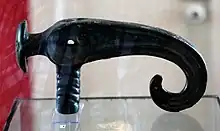Noua-Sabatinovka-Coslogeni complex
The Noua-Sabatinovka-Coslogeni complex was a late Bronze Age archaeological cultural complex located in Ukraine, Moldova and Romania, dating from the 14th to 11th centuries BC, consisting of the closely related Noua, Sabatinovka and Coslogeni cultures.[1][2][3][4] The complex originated from a westward migration related to the Srubnaya culture from the steppe and forest-steppe region north of the Black Sea,[5] combined with the preceding Monteoru culture in Moldova and Romania.[6] It was succeeded by the Urnfield culture (Gava culture)[7] and the Belozerka culture.[8]
| Geographical range | Ukraine, Moldova, Romania |
|---|---|
| Period | Bronze Age |
| Dates | 14th century - 11th century BC |
| Preceded by | Srubnaya culture, Monteoru culture, Wietenberg culture, Tei culture |
| Followed by | Urnfield culture, Gava culture, Belozerka culture |
Gallery
 Noua-Sabatinovka-Coslogeni bronze sceptre, Moldova.[9]
Noua-Sabatinovka-Coslogeni bronze sceptre, Moldova.[9] Noua-Sabatinovka-Coslogeni bronze artefacts, Moldova
Noua-Sabatinovka-Coslogeni bronze artefacts, Moldova
References
- "Bronze Age". The National Museum of History of Moldova. 2023.
- Boroffka, Nikolaus (2013). "Chapter 47: Romania, Moldova, and Bulgaria". In Harding, Anthony; Fokkens, Harry (eds.). The Oxford Handbook of the European Bronze Age. pp. 888–890. ISBN 978-0-19-957286-1.
The Late Bronze Age is marked by two cultural groupings, a south-eastern (Noua-Sabatinovka-Coslogeni) and a western (channelled pottery). ... in Moldova and Ukraine, a specific settlement type of the Noua-Sabatinovka-Coslogeni complex is the so-called ash-mound
- Parzinger, Hermann (2013). "Chapter 48: Ukraine and South Russia in the Bronze Age". In Harding, Anthony; Fokkens, Harry (eds.). The Oxford Handbook of the European Bronze Age. ISBN 978-0-19-957286-1.
The absolute chronology of the Noua culture, based on radiocarbon dating and synchronisms with the Carpathian Basin, fits in the fourteenth to thirteenth/twelfth centuries BC. To a large extent this corresponds to the beginnings of the Sabatinovka culture and emphasizes the contemporaneity of the two cultures.
- "Noua culture". Internet Encyclopedia of Ukraine.
- Boroffka, Nikolaus (2013). "Chapter 47: Romania, Moldova, and Bulgaria". In Harding, Anthony; Fokkens, Harry (eds.). The Oxford Handbook of the European Bronze Age. p. 889. ISBN 978-0-19-957286-1.
Noua-Sabatinovka-Coslogeni in Moldavia (both Romania and Moldova) and Transylvania is usually considered an eastern intrusion, reaching far back into the Ukraine and southern European Russia, where it may be connected to the Srubnaya culture.
- Boroffka, Nikolaus (2013). "Chapter 47: Romania, Moldova, and Bulgaria". In Harding, Anthony; Fokkens, Harry (eds.). The Oxford Handbook of the European Bronze Age. p. 889. ISBN 978-0-19-957286-1.
While the Noua ceramic repertoire does not have precursors in Transylvania and may indeed be intrusive there, most pottery shapes (and ornaments) can be derived from the preceding Monteoru culture of western Moldavia.
- Boroffka, Nikolaus (2013). "Chapter 47: Romania, Moldova, and Bulgaria". In Harding, Anthony; Fokkens, Harry (eds.). The Oxford Handbook of the European Bronze Age. p. 890. ISBN 978-0-19-957286-1.
The Early Iron Age sees the disappearance of the steppe influence (Noua-Sabatinovka-Coslogeni) and the spread eastwards of the early Hallstatt channelled pottery groups, closely connected to the Urnfield groups further west. A large northern block, represented by the Gáva-Holihrady culture, extends from eastern Hungary through the whole of Transylvania to Moldova.
- Kuzmina, Elena E. (2007). The Origin of the Indo-Iranians. Brill. p. 356. ISBN 978-90-04-16054-5.
In the 12th century BC the Sabatinovka sites disappeared being replaced by those of the Belozerka culture.
- "Bronze Age". The National Museum of History of Moldova. 2023.
This article is issued from Wikipedia. The text is licensed under Creative Commons - Attribution - Sharealike. Additional terms may apply for the media files.